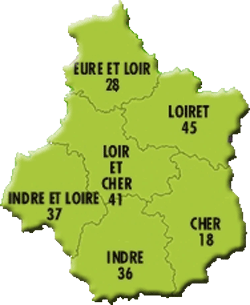 |
INDRE |
 |
|
| Commune |
|
Déols
Levroux
Neuvy-Saint-Sepulchre |
| |
|
Déols - Ancienne Abbatiale
Notre Dame (Musée) |
| The town of Déols is across the river from
the much larger Regional capital of Châteauroux
but the two towns appear to merge. The Abbey is in
a ruinous state with only its Romanesque tower still roofed. The
abbey ruins may be visited via a small museum, which houses a
collection of stone capitals and the effigy shown below.
Entrance to the museum and abbey ruins is free, although there
is a small charge to visit the tower. The whole complex has been
exceptionally well designed and executed. There is free street
parking in the town and we were able to park right outside the
abbey. |
 |
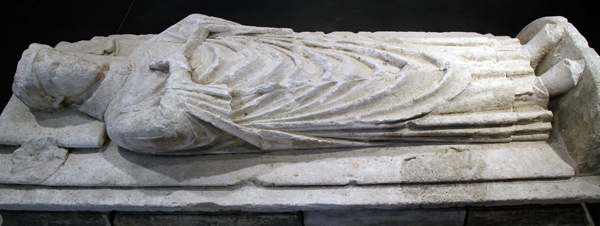 |
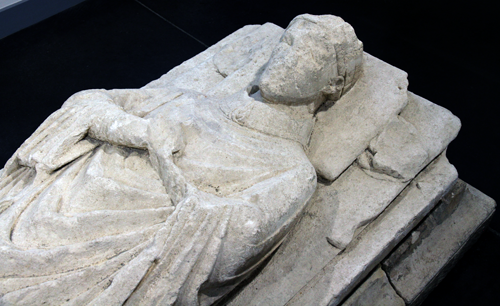 |
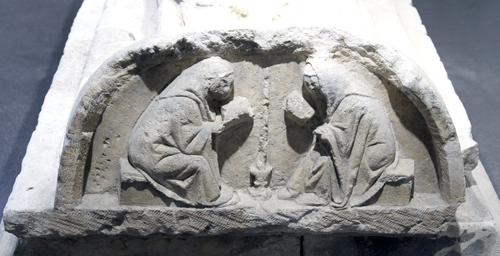 |
Unknown abbot 14th century.
Limestone found 1886 inside south transept of abbey church. Note
the two monks on the foot rest: they are reading on either side
of a flaming torch.
The monument was originally displayed in a museum at
Chateauroux. |
|
|
Neuvy-Saint-Sepulchre - Ancienne Collégiale Saint Jacques |
This long named town is a small town and
takes its name from the church, which is a copy of the Church of
the Holy Sepulcher in Jerusalem, in other words a round church
rather like the Temple Church in London. However unlike the
latter, which was a church of the Knight Templars, it was a
collegiate church staffed by canons. It appears to be the only
round church in France. Entry is free and there is a free
car part next to the Mairie, a very short walk away.
A curiosity: The English word sepulcher is translated
as sépulcre in French and sepulcrum in Latin,
so why the addition h in the name of this town? It is said that
a medieval monk wrote down a Latin pun when describing the
church by combining the noun sepulcrum with the Latin
adjective pulchre (beautiful). Hence 'beautiful
sepulcher'. If my dusty Latin is correct it would have been
sepulcrum pulchrum but then it had to be turned into French! |
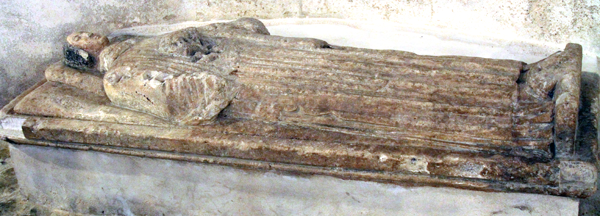 |
 |
An unknown canon 13th century. Limestone,
some polychrome.
The head is far too small for the monument and has clearly been
replaced at some time.
In the 'round' of the church |
|
 |
Levroux -
Collegiate Church of St Sylvaine at Levroux |
 |
| We made an unscheduled
lunch stop in this town: the usual sort of French town, in need
of a bit of restoration but with a good town square and free
parking. However there were signs to a medieval area which
contained this fine church with an unusual (for France) 17th
century monument. Near the church was one of those gentlemen's
public toilets made famous in the film Closh Merle;
however it was chained off and preserved as a historical
artifact! Nearby was a modern unisex 'pod' toilet with buttons
and lights and which has a total washdown after every use. |
Above left top:
Stone coffin excavated from the cemetery. Medieval
Left bottom: Monument to Ernest Nivet
(1871-1981) French sculptor and native of
Levroux. He worked under Auguste Rodin and created a number of
public sculptures. He died in Châteauroux
where he his buried. The memorial, carved by the sculptor, in
outside the church.
Right: François de Fiesque
(1621), Lord of Levroux.
Stone with black marble heart. He was killed at the Siege of
Montauban which was conducted by the young King Louis XIII from
August to November 1621. The King failed to capture this
Huguenot stronghold and abandoned the siege. After a lull
the King resumed his campaign with the Siege of
Montpellier, which ended in stalemate. This led to the Peace of
Montpellier in 1622 which temporarily confirmed the rights of
the Huguenots. |
|
| |
| |
| <Centre Index
Page> <Home - Index
-Page> |
| |
|












